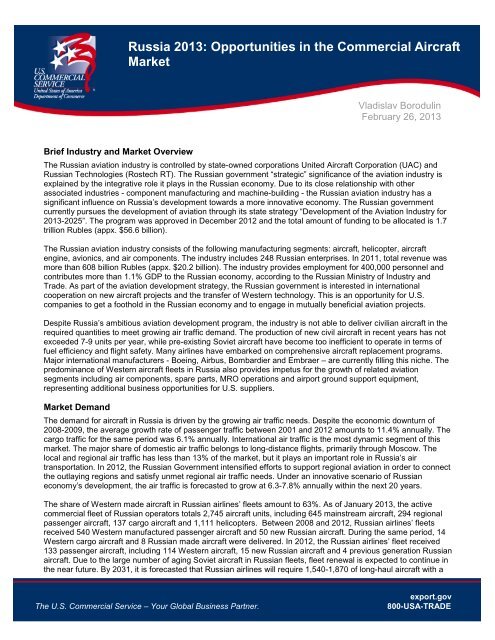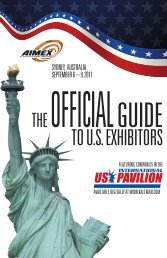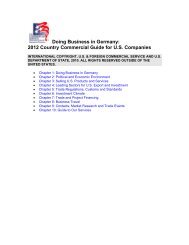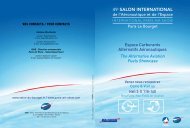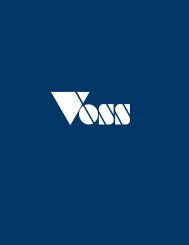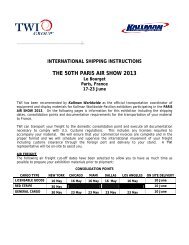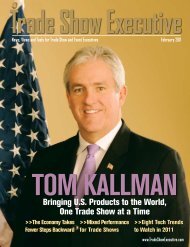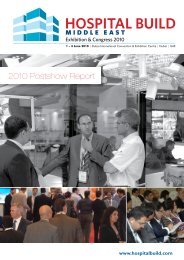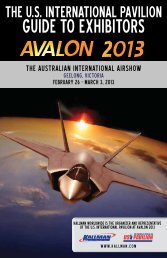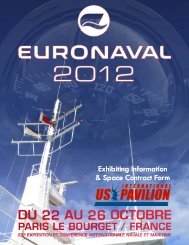Russia 2013 - Export.gov
Russia 2013 - Export.gov
Russia 2013 - Export.gov
You also want an ePaper? Increase the reach of your titles
YUMPU automatically turns print PDFs into web optimized ePapers that Google loves.
<strong>Russia</strong>: Opportunities in the Aviation Market 2012Page 1 of 5<strong>Russia</strong> <strong>2013</strong>: Opportunities in the Commercial AircraftMarketVladislav BorodulinFebruary 26, <strong>2013</strong>Brief Industry and Market OverviewThe <strong>Russia</strong>n aviation industry is controlled by state-owned corporations United Aircraft Corporation (UAC) and<strong>Russia</strong>n Technologies (Rostech RT). The <strong>Russia</strong>n <strong>gov</strong>ernment “strategic” significance of the aviation industry isexplained by the integrative role it plays in the <strong>Russia</strong>n economy. Due to its close relationship with otherassociated industries - component manufacturing and machine-building - the <strong>Russia</strong>n aviation industry has asignificant influence on <strong>Russia</strong>’s development towards a more innovative economy. The <strong>Russia</strong>n <strong>gov</strong>ernmentcurrently pursues the development of aviation through its state strategy “Development of the Aviation Industry for<strong>2013</strong>-2025”. The program was approved in December 2012 and the total amount of funding to be allocated is 1.7trillion Rubles (appx. $56.6 billion).The <strong>Russia</strong>n aviation industry consists of the following manufacturing segments: aircraft, helicopter, aircraftengine, avionics, and air components. The industry includes 248 <strong>Russia</strong>n enterprises. In 2011, total revenue wasmore than 608 billion Rubles (appx. $20.2 billion). The industry provides employment for 400,000 personnel andcontributes more than 1.1% GDP to the <strong>Russia</strong>n economy, according to the <strong>Russia</strong>n Ministry of Industry andTrade. As part of the aviation development strategy, the <strong>Russia</strong>n <strong>gov</strong>ernment is interested in internationalcooperation on new aircraft projects and the transfer of Western technology. This is an opportunity for U.S.companies to get a foothold in the <strong>Russia</strong>n economy and to engage in mutually beneficial aviation projects.Despite <strong>Russia</strong>’s ambitious aviation development program, the industry is not able to deliver civilian aircraft in therequired quantities to meet growing air traffic demand. The production of new civil aircraft in recent years has notexceeded 7-9 units per year, while pre-existing Soviet aircraft have become too inefficient to operate in terms offuel efficiency and flight safety. Many airlines have embarked on comprehensive aircraft replacement programs.Major international manufacturers - Boeing, Airbus, Bombardier and Embraer – are currently filling this niche. Thepredominance of Western aircraft fleets in <strong>Russia</strong> also provides impetus for the growth of related aviationsegments including air components, spare parts, MRO operations and airport ground support equipment,representing additional business opportunities for U.S. suppliers.Market DemandThe demand for aircraft in <strong>Russia</strong> is driven by the growing air traffic needs. Despite the economic downturn of2008-2009, the average growth rate of passenger traffic between 2001 and 2012 amounts to 11.4% annually. Thecargo traffic for the same period was 6.1% annually. International air traffic is the most dynamic segment of thismarket. The major share of domestic air traffic belongs to long-distance flights, primarily through Moscow. Thelocal and regional air traffic has less than 13% of the market, but it plays an important role in <strong>Russia</strong>’s airtransportation. In 2012, the <strong>Russia</strong>n Government intensified efforts to support regional aviation in order to connectthe outlaying regions and satisfy unmet regional air traffic needs. Under an innovative scenario of <strong>Russia</strong>neconomy’s development, the air traffic is forecasted to grow at 6.3-7.8% annually within the next 20 years.The share of Western made aircraft in <strong>Russia</strong>n airlines’ fleets amount to 63%. As of January <strong>2013</strong>, the activecommercial fleet of <strong>Russia</strong>n operators totals 2,745 aircraft units, including 645 mainstream aircraft, 294 regionalpassenger aircraft, 137 cargo aircraft and 1,111 helicopters. Between 2008 and 2012, <strong>Russia</strong>n airlines’ fleetsreceived 540 Western manufactured passenger aircraft and 50 new <strong>Russia</strong>n aircraft. During the same period, 14Western cargo aircraft and 8 <strong>Russia</strong>n made aircraft were delivered. In 2012, the <strong>Russia</strong>n airlines’ fleet received133 passenger aircraft, including 114 Western aircraft, 15 new <strong>Russia</strong>n aircraft and 4 previous generation <strong>Russia</strong>naircraft. Due to the large number of aging Soviet aircraft in <strong>Russia</strong>n fleets, fleet renewal is expected to continue inthe near future. By 2031, it is forecasted that <strong>Russia</strong>n airlines will require 1,540-1,870 of long-haul aircraft with aThe U.S. Commercial Service – Your Global Business Partner.export.<strong>gov</strong>800-USA-TRADE
<strong>Russia</strong>: Opportunities in the Aviation Market 2012Page 2 of 5significant share of narrow-body aircraft with varying seating capacity, and 420-500 regional passenger aircraft.The market need for cargo aircraft is much less significant and is not expected to exceed 260 aircraft.Best Prospects• New Aircraft Cooperation Projects - Sukhoi SuperJet-100 and MS-21 are two examples of internationalcooperation projects in which Western components and systems are widely used. Sukhoi SuperJet-100, putinto operation in 2011, is a regional medium-haul (3,000-4,500 km) aircraft with 60-100 passenger capacity.MS-21 is a short-to-medium (5,500 km) aircraft with 150-212 passenger capacity and will be put into operationin 2017. SuperJet-100 contains an estimated 80% of Western air components, while MS-21 has 50% Westerncomponents. In the future, the share of Western components for the MS-21 is planned to be reduced down to15%. U.S. companies are advised to monitor current and future projects in the <strong>Russia</strong>n market for businessopportunities. High level contact with representatives of UAC and Rostech is preferred, and frequent visits to<strong>Russia</strong> are recommended. It is also important to be aware of local and international competitors alreadypresent in the market to better assess one’s own chances of winning contracts.• Air Part Supplies - The quickly expanding Western aircraft fleets drive up the demand for aircraft spare partsand replacement components. The <strong>Russia</strong>n aircraft spare parts market is estimated at $600-700 million peryear, according to Locatory.com, a global e-business aircraft spare parts platform. <strong>Russia</strong>n airlines spendabout $150 million annually for maintenance and repair of 500 medium-haul Western aircraft (Boeing, Airbus),$120 million annually for 300 long-haul Western aircraft and $18 million monthly for 60 regional Westernaircraft (Bombardier, CRJ). While most <strong>Russia</strong>n airlines may already have well-established air parts supplierarrangements, some of them still continue to seek out opportunities, looking for better pricing, widerassortment, and more efficient delivery. Setting up one’s own air parts stock in <strong>Russia</strong> is considered by<strong>Russia</strong>n airlines and parts distributors as an attractive competitive advantage in this market segment.• Microelectronics Product Supplies - The <strong>Russia</strong>n electronics industry- which is the basis for the aviation,aerospace and the defense industry segments - is lagging behind in the serial production of electronicscomponents compared to Western manufacturers. New products are being developed and tested, but untilthey are put into serial production, imports will continue to play an important role in filling in this market need.The types of products in demand are: semi-conductors, integrated circuits, power and high frequency modules- items that serve as production components for various systems and modules. Finding a local distributor withconnections in various industries is considered to be an effective marketing strategy in this segment.• Localized Western Aircraft Production and MRO - <strong>Russia</strong>’s state corporation <strong>Russia</strong>n Technologies iscurrently in joint venture negotiations with Bombardier to build the Q400 business aircraft in Ulyanovsk-Vostochny Special Economic Zone (SEZ). Rostech CEO Sergei Chemezov indicated the deal will be a 50-50joint venture with an estimated investment of about $100 million. However, no legally binding documents havebeen signed yet. In August 2012, FL Technics Ulyanovsk, a subsidiary of the international aviation serviceprovider Avia Solutions Group (Lithuania), became the first resident company at Ulyanovsk-Vostochny SEZ toprovide various MRO services, including A to D checks, engine and landing gear replacement, avionics andairframe modifications, flight hour inspections, structure maintenance, component maintenance and interiordesign-related services. FL Technics Ulyanovsk will provide maintenance service to both narrow and widebody aircraft, including the Airbus А320 and A380, Boeing 737 Classic, 737NG, 777, 787, 747 BombardierCRJ 200, Sukhoi Superjet 100.Ulyanovsk-Vostochny SEZ is part of the Special Economic Zones, a daughter structure of the Ministry ofEconomic Development of <strong>Russia</strong>, funded 70% federally and 30% regionally. Ulyanovsk-Vostochny offersfiscal discounts—no property, land, or transport taxes, lower profit tax (15.5% for residents), and the option oflocating and using foreign goods (equipment, raw, components, construction materials) without paying dutiesand VAT. Special Economic Zones are becoming more common in <strong>Russia</strong>.The U.S. Commercial Service – Your Global Business Partner.export.<strong>gov</strong>800-USA-TRADE
<strong>Russia</strong>: Opportunities in the Aviation Market 2012Page 3 of 5Key SuppliersBoeing opened a sales office in Moscow in 1992 andhas been co-operating with <strong>Russia</strong>n aircraft designbureaus and scientific institutions through its Moscow-based Technical Research Center since 1993. In 1998,the Boeing Design Center was added. The Design Center employs <strong>Russia</strong>n aerospace companies, mainly forstructural engineering work, but also for manufacturing studies and systems engineering for its commercialaircraft range. While the design centre is owned by Boeing, most of its 1,200 staff comes from <strong>Russia</strong>npartners such as Ilyushin and Sukhoi. In 2007, Boeing and VSMPO-AVISMA, the largest <strong>Russia</strong>n titaniummanufacturer, set up Ural Boeing Manufacturing (UBM), a 50/50 equity joint venture in Verkhnya Salda, toproduce titanium parts for the Boeing 787 Dreamliner passenger jet.Airbus has a regional office in Moscow to cover sales, marketing and public relations, develop cooperationprojects with the <strong>Russia</strong>n aviation industry, and provide on-the-spot airline support. The Engineering CenterAirbus in <strong>Russia</strong> (ECAR) was established in Moscow in 2003 and employs about 200 engineers who concentratemainly on airframe structures. The team handles about half of the fuselage-related structural work for the A330-200 freighter and now focuses on the A350 and A320 winglets. The company’s main partner in <strong>Russia</strong> is IrkutCorporation, which is supplying the nose landing gear bay, keel beam and flap track for the A320 family. VSMPO-Avisma is another key partner to Airbus and its parent company, EADS, currently covering 60% of the group’stitanium needs in semi-finished products and titanium forgings. In recent years, VSMPO-Avisma activities forAirbus are not limited to the supply of raw material and forging, but also extend to rough and pre-machining or oftitanium parts for the landing gear of the A380 family.United Technologies Corporation (UTC) established a representative office in Moscow in 1992. Comprised ofseveral business units, UTC pursues various projects in several industries including aviation. In 2009, Pratt &Whitney was chosen as a supplier of Geared Turbofan engine for the new <strong>Russia</strong>n MS-21 aircraft project. Thedefinitive agreement on PurePower PW1400G engine for MS-21 aircraft was signed in June, 2012. IrkutCorporation also selected Hamilton Sundstrand electric integration systems for with Sukhoi Super Jet. Thecontract was signed in May 2006. In October 2011, Hamilton Standard Nauka joint venture was established tomanufacture commercial aircraft heat exchanger management systems. HS-Nauka JV is the sole supplier of heatexchangers for the Boeing 787 and Airbus A380. Sikorsky is currently collecting and analyzing information on thelocal market’s capacity for the company’s main commercial aircraft, certification procedure, marketing and MROopportunities.Rockwell Collins opened a sales and service support office in Moscow in 1991. In the last few decades,Rockwell Collins has offered many commercial products to ensure that <strong>Russia</strong>n aircraft meet FAArequirements to fly to the United States and Europe. Systems such as TCAS-II were certified on many<strong>Russia</strong>n made aircraft, including the Tu 134, Tu 154, IL 62, IL 76, IL 86, Yak 40, Yak 42, An 12/An 24/26/32,An 140 and An 148. With the expansion of updated <strong>Russia</strong>n fleets over the last few decades, RockwellCollins has increased its presence and established the Moscow Engineering Center to provide specializedsupport and development for the new avionics systems for <strong>Russia</strong>n commercial aircraft.Honeywell opened a representation office in Moscow in 1974, followed by branch offices in St Petersburg andKiev in 1992. <strong>Russia</strong> is currently Honeywell’s largest national market within the Commonwealth ofIndependent States (CIS) from the former Soviet Union. All four major Honeywell Strategic Groups arerepresented: Aerospace, Automation and Control Solutions, Performance Materials and Technologies, andTransportation Systems. Honeywell auxiliary power units, brakes, and avionics are widely used on <strong>Russia</strong>naircraft and helicopters. Honeywell took part in the design of the Sukhoi SuperJet-100 auxiliary power systemin cooperation with the <strong>Russia</strong>n company MMPP Salyut.Prospective Buyers<strong>Russia</strong>n airlines are the principle end-users of commercial aircraft, parts and equipment. In 2012, the number ofcommercial airlines dropped to 120, as compared to the maximum of 393 in 1993. Four major <strong>Russia</strong>n airlines(Aeroflot, Transaero, UTair and S7 Airline) account for 60% of passenger traffic and a total of fourteen airlinesaccount for 90% of all passenger traffic in <strong>Russia</strong>.The U.S. Commercial Service – Your Global Business Partner.export.<strong>gov</strong>800-USA-TRADE
<strong>Russia</strong>: Opportunities in the Aviation Market 2012Page 4 of 5The <strong>Russia</strong>n aircraft and air component manufacturers under the umbrella of the United Aircraft Corporation(UAC) represent another group of prospective buyers. One of the most successful companies is Sukhoi,which possesses a wide portfolio of internationally competitive military aircraft, including the Su-27, Su-30 andSu-35 models. In the commercial aircraft segment, the company's most important project is the Superjet 100.Komsomolsk-on-Amur Aircraft Production Association, <strong>Russia</strong>'s largest aircraft enterprise located in the<strong>Russia</strong>n Far East, is responsible for manufacturing Sukhoi products. Joint Stock Company Tupolev focuseson the commercial aircraft market with its Tu-204 and Tu-214 model. Mass production of Tu-204 aircraft iscarried out by Aviastar SP, located in Ulyanovsk; while the Tu-214 variant is produced by Kazan AircraftProduction Association. Ilyushin focuses on the military cargo and transport sector. The main manufacturer ofIlyushin aircraft is the Voronezh Aircraft Production Association. Irkut Corporation has a portfolio of trainer andamphibious aircraft projects and competes in the onboard electronics and avionics niche. In the unmannedaerial vehicle segment, ZALA Aero and Vega Radio Engineering Corporation are among the leadingcompanies.Besides UAC, other significant state corporations are: ‘Helicopters of <strong>Russia</strong>’ Holding, Oboronprom and<strong>Russia</strong>n Technologies (Rostech RT). ‘Helicopters of <strong>Russia</strong>’ Holding is the managing body of theconsolidated <strong>Russia</strong>n helicopters industry, represented by five helicopter assembly plants, two designbureaus, two components product plants, one overhaul and one helicopter service company providingaftermarket services in <strong>Russia</strong> and abroad. Oboronprom has 100% ownership of the ‘Helicopters of <strong>Russia</strong>’Holding. Oboronprom is one of the largest <strong>Russia</strong>n diversified industrial-investment groups in theengineering and high technologies industries. Besides helicopters, Oboronprom also monitors production ofaircraft engines and compression stations, and the unique Pechora-2M air defense missile system.Rostech RT has 32% ownership of Oboronprom. Rostech RT is a state owned corporation established in2007 to promote development, production and exportation of high technology products. Rostech RT hasconsolidated assets of about 663 <strong>Russia</strong>n enterprises along three main segments of the <strong>Russia</strong>n economy:defense industry, civil strategic assets and ventures with dual use technologies, and civil assets of nonstrategicsignificance.Market EntryIn doing business in the <strong>Russia</strong>n market, it is often not the product, but the attitude and the way in whichbusiness is performed that really matters. The desired attitude is best described by <strong>Russia</strong>n partners whenasked how U.S. firms can succeed in this market: “It is important to invest oneself”. This means not only afinancial investment such as setting up a representative office, sharing costs for product promotion or tradeshow booth rental with a <strong>Russia</strong>n partner, but also, most importantly, a certain degree of commitment to<strong>Russia</strong>n partners. This is especially true, when it comes to forging strategic partnerships with <strong>Russia</strong>n highlevel aviation industry representatives, such UAC, Rostech RT and ‘Helicopters of <strong>Russia</strong>’ Holding. Frequentcontact including trips to <strong>Russia</strong> to meet with <strong>Russia</strong>n partners and principle customers and physicalpresence at trade shows are all very important in the <strong>Russia</strong>n market. Building brand recognition and a longtermapproach are very important.Along with country commitment, a U.S. company should also promote a competitive advantage over theirEuropean competitors that will allow a U.S. company to win contracts. The <strong>Russia</strong>n market is generally verycompetitive. In the air parts segment, for example, <strong>Russia</strong>n partners appreciate competitive prices, integratorsolutions capabilities (access to a wide range of parts), private warehousing (preferably in Europe) and a wellranlogistics route as selling points. Imports are sometimes viewed as an initial phase of cooperation thatmay lead to offers of localization or technology transfers. In the air parts segment, localization of consignmentstock of commercial western parts may be viewed positively by <strong>Russia</strong>n partners and increase theircommitment to work with a U.S. supplier.Market Issues & ObstaclesAccording to <strong>Russia</strong>n legislation, commercial aircraft are divided into seven groups. Some of them are either fullyor temporarily exempt of the import duty. The others are subject to 20% import duty, a customs fee (up to$30,000) and 18% VAT. The end users may have to pay up 40% of the original price in taxes or duties. UnlikeThe U.S. Commercial Service – Your Global Business Partner.export.<strong>gov</strong>800-USA-TRADE
<strong>Russia</strong>: Opportunities in the Aviation Market 2012Page 5 of 5private individuals, commercial operators can reimburse VAT, according to <strong>Russia</strong>n tax code. With <strong>Russia</strong>’s WTOaccession, the import duty (for helicopters and civil aircraft) is expected to be reduced to an average of 7.8%within the seven year implementation period from the date of accession (August 2012).Trade EventsHELI-RUSSIA (International Helicopter Show), May 16-18, <strong>2013</strong>. Location: Moscow, <strong>Russia</strong>.www.helirussia.ru/MAKS-<strong>2013</strong> (International Aviation and Space Show), August 27-Sept 1, <strong>2013</strong>. Location: Moscow, <strong>Russia</strong>.http://www.aviasalon.comJET-EXPO (International Business Aviation Show), September 19-21, <strong>2013</strong>. Location: Moscow, <strong>Russia</strong>http://2012.jetexpo.ru/en/about-us/jet-expo-<strong>2013</strong>.html,AERO TESTING RUSSIA (Aerospace Testing Equipment), October 22-24, <strong>2013</strong>. Location: Moscow, <strong>Russia</strong>http://www.aerospace-expo.ruResources & ContactsUnited Aircraft Corporation http://www.uacrussia.ruMikhail Pogosyan, UAC PresidentATO (Air Transport Observer) Events http://www.events.ato.ru/eng/Organizer of professional events in the <strong>Russia</strong>n aviation community<strong>Russia</strong>n Aviation News & Information Server http://www.aviaru.net/english/Aviation News Agency “Aviaport” (only in <strong>Russia</strong>n) http://www.aviaport.ru/<strong>Russia</strong>n aviation industry news portal (English) http://www.russianavia.net/For More InformationIf you wish to obtain more information on the <strong>Russia</strong>n Aviation Market and market entry strategies, please contactBridgette Clark (Bridgette.Clark@trade.<strong>gov</strong>) or Vladislav Borodulin (vladislav.borodulin@trade.<strong>gov</strong> ) of the U.S.Commercial Service in Moscow, <strong>Russia</strong>. Phone: +7(495) 728-5235; Fax: +7(495) 728-5585 and visit our website:www.buyusa.<strong>gov</strong>/russia/en.The U.S. Commercial Service — Your Global Business PartnerWith its network of offices across the United States and in more than 80 countries, the U.S. Commercial Service ofthe U.S. Department of Commerce utilizes its global presence and international marketing expertise to help U.S.companies sell their products and services worldwide. Locate the U.S. Commercial Service trade specialist in theU.S. nearest you by visiting http://www.export.<strong>gov</strong>/eac.Comments and Suggestions: We welcome your comments and suggestions regarding this market research.You can e-mail us your comments/suggestions to: Customer.Care@mail.doc.<strong>gov</strong>. Please include the name ofthe applicable market research in your e-mail. We greatly appreciate your feedback.Disclaimer: The information provided in this report is intended to be of assistance to U.S. exporters. While we make everyeffort to ensure its accuracy, neither the United States <strong>gov</strong>ernment nor any of its employees make any representation as to theaccuracy or completeness of information in this or any other United States <strong>gov</strong>ernment document. Readers are advised toindependently verify any information prior to reliance thereon. The information provided in this report does not constitute legaladvice. The Commercial Service reference to or inclusion of material by a non-U.S. Government entity in this document is forinformational purposes only and does not constitute an endorsement by the Commercial Service of the entity, its materials, orits products or servicesInternational copyright, U.S. Department of Commerce, 2007. All rights reserved outside of the United States.The U.S. Commercial Service – Your Global Business Partner.export.<strong>gov</strong>800-USA-TRADE


